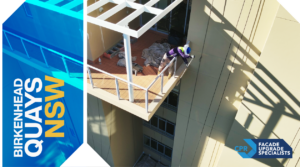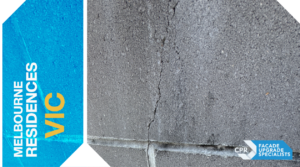The Importance of a Building Facade Audit
Australian high-rise buildings face continuous exposure to harsh conditions—sunlight, wind, moisture, and salt air—which gradually degrade facade integrity, safety, and appearance. Regular comprehensive facade audits, recommended by standards like the National Construction Code (NCC) and NSW facade inspection regulations, are crucial. These audits identify problems early, prevent costly damage, and ensure buildings remain safe and compliant with current regulations.
Key Elements of a Building Facade Audit
A detailed building facade audit includes multiple assessments, providing a clear and comprehensive understanding of your facade’s health:
1. Visual and Physical Assessments
- Thorough inspection of cladding, glazing, sealants, and structural fixings.
- Identification of visible defects such as cracks, corrosion, delamination, or water penetration.
- Photographic documentation to clearly illustrate any issues.
2. Structural Integrity Audit
- Detailed engineering review of facade stability and load-bearing capacity.
- Specialised diagnostic tools, including drone and rope-access inspections.
- Recommendations for addressing any structural concerns found.
3. Compliance and Safety Checks
- Verifying facade compliance with NSW regulations and the NCC.
- Fire safety assessments, including checks on combustible cladding.
- Comprehensive completion of a facade safety audit checklist.
Facade Inspection Checklist Essentials
Every audit should include a detailed checklist covering:
- Condition of facade materials (cladding, render, paint, glass).
- Evidence of moisture penetration or leaks.
- Window and joint integrity.
- Signs of structural deterioration or movement.
- Corrosion checks for fixings and supports.
Facade Risk Assessment and Reporting
A professional facade audit highlights common issues like cracks, corrosion, moisture ingress, and structural weaknesses, clearly detailing their severity and urgency. The report provides recommendations for immediate action, estimates costs, and proposes timelines for repairs.
Remedial Facade Engineering Services

Should significant problems be identified, CPR’s engineers create specific remediation strategies. For example, our team recently managed a 25-storey apartment complex project in Sydney, effectively resolving severe water ingress and facade deterioration, significantly enhancing property safety and value. Our services also include long-term monitoring and maintenance plans.
Explore Our Building Facade Inspection Services →
Who Should Consider a Facade Audit?
- Strata committees and building managers of high-rise properties.
- Property owners needing compliance with Australian regulations.
- Buildings subject to mandatory facade inspections under NSW laws.
What a Comprehensive Facade Audit Should Include:
A detailed facade audit systematically covers these critical areas:
1. Visual Inspection
- Checking for cracks, stains, rust, spalling, and efflorescence.
- Ensuring cladding, panels, render, or tiles are secure and intact.
- Evaluating seals, joints, and window perimeters.
2. Physical Testing (when required)
- Tap hammer tests for detecting hidden defects.
- Pull tests to check anchor strength.
- Material sampling, such as concrete or render.
3. Structural Integrity
- Reviewing facade support structures like brackets and frames.
- Assessing load-bearing capacities.
- Inspecting for corrosion in structural components.
4. Water and Moisture Checks
- Identifying water damage or mould growth.
- Using moisture meters or infrared technology (optional).
- Checking window and joint conditions.
5. Thermal and Energy Analysis (valuable for sustainable buildings)
- Reviewing thermal bridging and insulation.
- Evaluating facade impact on energy performance.
6. Fire Compliance
- Identifying cladding materials (e.g., ACP, EPS).
- Ensuring cladding meets fire safety standards.
- Verifying compliance with NSW or VBA guidelines.
7. Safety and Access Review
- Inspecting anchor points and maintenance access systems.
- Confirming safety system compliance (AS/NZS 1891 or AS 1657).
- Checking safe access routes for future maintenance.
8. Documentation Review
- Examining original facade design and materials.
- Checking past inspections and maintenance records.
- Reviewing material warranties.
9. Photographic and Drone Documentation
- Capturing clear, detailed images of facade conditions.
- Using drones for high-rise and difficult-to-access areas.
10. Condition Grading and Risk Rating
- Classifying defect severity (minor, moderate, critical).
- Providing clear repair priorities.
11. Remediation Recommendations
- Immediate safety measures (e.g., barricades).
- Medium-to-long-term repair strategies.
- Preventative maintenance suggestions.
12. Detailed Reporting
- Precise mapping of defects.
- Comprehensive photographic documentation.
- Detailed repair recommendations.
- Summarising risks and regulatory compliance.
CPR’s Proven Facade Audit Process
CPR’s audits combine decades of industry expertise with cutting-edge technology to deliver precise, actionable recommendations:
- SFS360® diagnostic system: Accurate facade condition assessments.
- MARS™ and PEARS® rope-access systems: Non-disruptive, comprehensive inspections.
- Extensive visual, physical, and diagnostic evaluations.
Why Choose CPR?
- Over 30 years specialising in facade inspections.
- Experienced, certified engineers and technicians.
- Detailed, actionable reports.
- Proven track record ensuring compliance and building safety.






